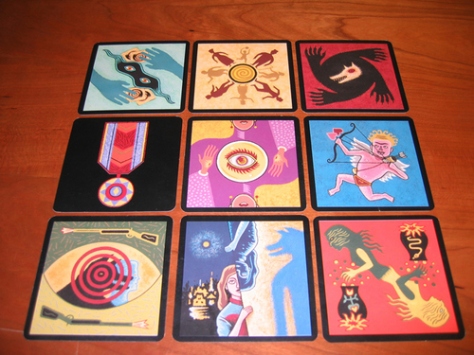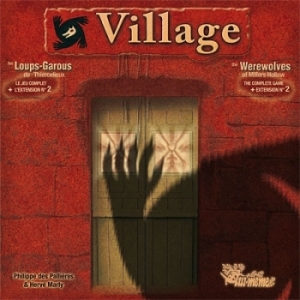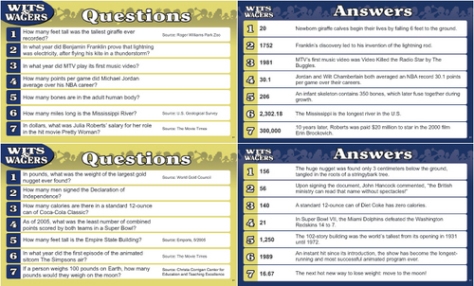Don’t know why it took me so long to write about it – I probably figured everybody already knew about it. If you’re reading a board and card game blog, then you have definitely enjoyed Uno (1971, Mattel and others; $6, 2-10 players) at some point, or some period, or all of, your life. But I’ve crowned it my #1 family game, so it’s just irresponsible to not have it discussed here. Someone might come along who hasn’t played it before, and wonders what the fuss is all about. So here it is: Uno.  Uno is basically a commercial version of the traditional card game Crazy 8’s. Players start with seven cards, and go around the table playing one card at a time onto a discard deck. The card must be of the same color (i.e., suit) or rank, or it must be a wild card, in which case the player can name the new color. The goal each round is to be the first player to empty his/her hand – which can only happen after they have ONE (Uno!) card left.
Uno is basically a commercial version of the traditional card game Crazy 8’s. Players start with seven cards, and go around the table playing one card at a time onto a discard deck. The card must be of the same color (i.e., suit) or rank, or it must be a wild card, in which case the player can name the new color. The goal each round is to be the first player to empty his/her hand – which can only happen after they have ONE (Uno!) card left.  The beauty and fun of the game is in the surprise cards. Each color contains a few each of the Skip card, that prevents the next player from taking a turn, the Reverse card, that changes the direction of play, and the Draw Two card that forces the next player to pick up two cards instead of discarding. The ultimate surprise card is the Wild Draw Four Card, which can be played onto anything, and requires the next player to pick up four instead of discarding.
The beauty and fun of the game is in the surprise cards. Each color contains a few each of the Skip card, that prevents the next player from taking a turn, the Reverse card, that changes the direction of play, and the Draw Two card that forces the next player to pick up two cards instead of discarding. The ultimate surprise card is the Wild Draw Four Card, which can be played onto anything, and requires the next player to pick up four instead of discarding.  That’s all there is to it – it’s not entirely random, but there is no controlling what card you’ll pick up next, or what your neighbors will do to you. The bottom line is that it’s a lot of fun and can be enjoyed by adults, kids, adults and kids, and so on. It comes as a deck in a thin box and is entirely portable, and it’s enjoyed all over the world. It also comes in literally hundreds of variations, and has featured many, many licensed entities. And for a $6 game, there is no reason why every house shouldn’t have an Uno deck.
That’s all there is to it – it’s not entirely random, but there is no controlling what card you’ll pick up next, or what your neighbors will do to you. The bottom line is that it’s a lot of fun and can be enjoyed by adults, kids, adults and kids, and so on. It comes as a deck in a thin box and is entirely portable, and it’s enjoyed all over the world. It also comes in literally hundreds of variations, and has featured many, many licensed entities. And for a $6 game, there is no reason why every house shouldn’t have an Uno deck.
Category Archives: 10 + player games
Werewolves of Miller’s Hollow
I finished my last game of The Werewolves of Millers Hollow (999 Games, 2001) less than 10 hours ago, and I can’t really wait to tell you about it! This is such a unique game, and the interaction is so interesting, that I’m a little embarrassed and ashamed that I waited so long to play it! (And I call myself a game lover – bah!)
In this game, players (except for the “Moderator”) play the part of simple townsfolk – but some of them are werewolves and wake up at night to kill an innocent victim, and then arise in the morning among the rest of the townsfolk. The townsfolk then all try to decide who among them might be a werewolf, and the player chosen is lynched! Of course, that player may end up being a werewolf, or an innocent victim. Eventually, there are only werewolves or townsfolk left, and they have won the game.
The key to The Werewolves of Millers Hollow is that players do not know the actual identity of any of the other players (per cards, above), and when nighttime falls, all players close their eyes as if asleep, only “waking” when they have a role to play. There are only a few werewolves – up to four – per game, but they are the only ones who know who they are, and when they mingle with the rest of the townsfolk during they day they must avoid being found out.
So the game starts when the moderator, whose job it is to run the game and communicate decisions among the players without giving away identities, deals a card to each player. That card becomes that player’s identity (see below). Ordinary Townsfolk simply close their eyes during the night phase, and open them when night is over, and then help try to determine who might be a werewolf during the day. The Werewolves act like townsfolk, but during the night phase they, at the moderator’s cue, open their eyes and communicate silently to decide on a victim. The moderator then silently taps the victim to let them know they were killed by the werewolves, and the werewolves close their eyes again. When the moderator announces morning time, everyone except the victim opens their eyes, and the victim’s identity is revealed.
When the day begins, all players (including the werewolves, who are acting like regular townsfolk) debate and choose by vote which other player is a werewolf. That unlucky player is “lynched” and then their identity is revealed (By the way, when players are “killed” they are out of the game, and may not participate…but it is still a lot of fun to watch!). The (optional) sheriff card can go to any player, by vote of all players at the beginning of the game, and that role confers on them two votes when deciding who is a werewolf. That can be particularly bad if a werewolf ends up becoming elected sheriff, because as the number of players dwindle, those two votes are increasingly powerful!
 If a player is not a werewolf, they are a townsfolk (but the sheriff can be either). The townsfolk may be ordinary, or they may have a special role. The Fortune Teller (above) wakes up first after all the town has gone to sleep, and they get to “peek” at another player’s identity. It is up to them, after that, how to use the information.
If a player is not a werewolf, they are a townsfolk (but the sheriff can be either). The townsfolk may be ordinary, or they may have a special role. The Fortune Teller (above) wakes up first after all the town has gone to sleep, and they get to “peek” at another player’s identity. It is up to them, after that, how to use the information.
More special townsfolk cards are below. The Little Girl has the option of opening her eyes while the werewolves are awake, to peek at them – however, if she is caught peeking at them then she will automatically become the next victim! The witch has two potions, one for healing (bringing back one dead person) and one poison (for eliminating one person); the witch wakes up after the werewolves have killed and gone back to sleep, and she determines whether to use her healing or poison potion that night, or not. She may use each only once, and they may be used on herself.
 At the beginning of the game, the Thief may opt to remain a regular townsfolk, or they may choose one of two remaining cards from the deal. The Hunter, when killed, gets one shot at one player, taking that player with him. Cupido gets to play matchmaker – any two players of Cupido’s choice become instantly in love and MUST protect the interests of their loved one. If one of the lovers dies, the other must follow (by taking their own life!).
At the beginning of the game, the Thief may opt to remain a regular townsfolk, or they may choose one of two remaining cards from the deal. The Hunter, when killed, gets one shot at one player, taking that player with him. Cupido gets to play matchmaker – any two players of Cupido’s choice become instantly in love and MUST protect the interests of their loved one. If one of the lovers dies, the other must follow (by taking their own life!).
And so goes The Werewolves of Millers Hollow. The game is so exquisitely interesting because each person has information to share and an identity to hide at the same time, and they do not know who is who. It’s a game of guesses (usually wrong on my part – lol!), suspicion, hunches, and luck. It takes about 20 minutes or so (depending on how many are playing) to play a single game, but as I said earlier it is very easy to play many games in a row. In fact it’s hard not to.
I absolutely recommend this game to any group of people gathering just about anywhere. It would even be great for more formal gatherings where there is a need for an ice breaker or a team-building type exercise. I can envision modifications to make it even better for something along those lines. That said, it is also perfect for later nights, when the more raucous games, or the more serious games, are over and there are enough people left behind to make it work.
There is an expansion of The Werewolves of Millers Hollow called “New Moon,” and a re-implementation called The Village (that is, it’s a newer version of the original with added features); see pictures below. I have yet to try these, but you know they are high on my list!
Guesstures
There’s a reason charades has been enjoyed for the better part of the past 400 years; both King Louis XIV and Catherine the Great were apparently fond of them, and it was being played by Scrooge’s nephew Fred at his party in Dickens’ A Christmas Carol. Charades can be played with a group of friends as well as a group of strangers, no props are required, everyone is always involved, and laughter generally ensues.
So it is no surprise that games involving the “guessing game” mechanism of charades are still popular today. Guesstures (Parker Brothers, 1990) has been in game closets now for 20 years because it introduced a clever time limit mechanism to the classic game. The time limit takes the frantic suspense of ordinary charades and “kicks it up a notch.”
There are only a few components in Guesstures (older edition, above), and it’s a very simple game to learn and to play. Players split into two teams and, on their turn, one person from their team will be the reader, while all others are guessers. The readers have to try to get their teammates to guess the words on each of four cards in order to score the points associated with those words. But there is a timer involved….
The picture above shows the Timer/Dropper, which is the interesting innovation in Guesstures. There is a spring-loaded timer on the right of the unit (out of sight) that is wound, like an old-fashioned clock, each turn, and it is locked in place until the reader is ready. The cards are put in place as shown above, and when the timer is activated, the reader must get his or her team to guess each word, in order. If the team guesses the word, the reader must physically retrieve that card and pull it out of the unit – before it falls. Yes, before it falls. The timer is connected to a platform that is supporting each card. After a short while, the platform allows the first card to fall, then the second, then the third, and finally the fourth. If the team can’t guess the word, or the reader can’t grab them fast enough, the card is lost to them and earns zero points.
The cards come in two colors, and each card offers a choice of two words – one is more difficult than the other and earns more points, and the two different colors also represent difficulty levels. The reader gets to choose which word will be facing up for his or her team to guess that round, and stands to win whatever the point value is.
Guesstures is one of those games that is an absolutely safe bet for a party. It stands a good chance at being what it takes to really get things going, or it might not, but it won’t bomb. I recommend it to just about any group of people who want to have fun together; hard core gamers can take a break from the intensity of the strategy games and have some lighthearted fun, and casual acquaintances can break the ice and laugh without fear of sounding ridiculous, or at least more ridiculous than anyone else.
Wits & Wagers
So…you have about 20 people over and it’s kind of boring, no one’s really talking about anything interesting and people aren’t too familiar with one another. What do you do? You break out Wits & Wagers (North Star Games, 2005), that’s what!
Billed (accurately) as “The trivia game for people who don’t know stuff,” Wits & Wagers is a trivia game in the sense that you have to answer questions – but rewards don’t come from knowing the answers, they come from placing bets on the players who do know the right answers.
Now in its second edition, the game includes a 28-inch-long felt betting mat, poker chips, trivia cards, player betting markers (2 each in 7 different colors),7 dry-erase pens and mini-boards, and a sand timer. Up to 21 people can play, forming as many as seven teams (individuals may play alone as well).
The goal of the game is to finish with the most points after seven rounds. On each round, a “question reader” reads the appropriate question on the card – the first question for the first round, and so on – and each player or team comes up with their best guess at the answer. The questions always have a numerical answer, typically one that very few people will know outright (see below). Teams have 30 seconds to record their answers, after which the answers are revealed and placed in order of magnitude (lowest to highest) on the large betting mat.
Players then have 30 seconds to place up to two bets on any of the answers, hoping to win one of 4 payoffs (2:1, 3:1, 4:1, or 5:1). Players may also bid on an eighth space, for a 6:1 payoff, labelled: “The correct answer is smaller than all given answers.” Players then identify their bids by placing their colored betting markers on their bets, and then the answer is revealed. The answer that comes closest to correct without going over is considered correct, and all players who bet on this answer receive the corresponding payoff. The player whose answer was chosen also gets 10 bonus points. If all answers went over, there is no bonus given, and only players who bet all answers were too high wins a payoff.
When I first played Wits & Wagers, we had a group of over 20 people (at a board-gaming event), and more were attracted by the laughing and fun. Since then it has not failed to please.
I recommend Wits & Wagers for any family or group that is likely to get larger than, say, 8 people. The more the merrier with this game, but it is still plenty of fun for 6 or more. It is intellectually stimulating, but, as advertised, one need not know anything about trivia to enjoy or even win the game. It is sufficient to know the right people to bet on from turn to turn.
Apples to Apples
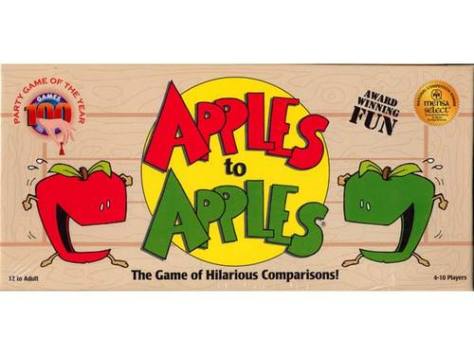 Once a decade a game strikes just the right chord with the public and flies off the shelves. Apples to Apples (Out of the Box, 1999) is such a game. This game has been played and enjoyed by so many people, and their friends, and friends of those friends, and so on, that people all over the world who “don’t play games” have loved it. It defied all odds and sold a million copies in the US without ever having been on the shelf of WalMart (as of that point in time).
Once a decade a game strikes just the right chord with the public and flies off the shelves. Apples to Apples (Out of the Box, 1999) is such a game. This game has been played and enjoyed by so many people, and their friends, and friends of those friends, and so on, that people all over the world who “don’t play games” have loved it. It defied all odds and sold a million copies in the US without ever having been on the shelf of WalMart (as of that point in time).
Apples to Apples is a social game; it stimulates conversation, elicits laughter, moves fast, and keeps every player constantly involved. It is comprised of two decks of cards. One deck is green; green cards each have an adjective listed, along with a few synonyms. The other deck is red; red cards each have a noun (person, place, or thing), along with a brief – and humorous – description. One player acts as judge each round, and turns over the green (adjective) card and reads it. Each other player must choose the red (noun) card from their hand of seven that he or she thinks is best described by the green card. The judge takes the submitted red cards without looking at them or knowing which player submitted which card, and then judges them; he or she will decide which of the red cards really is the best match to the green card (see pic). The player whose card is chosen wins the green card; The first player to seven green cards wins.
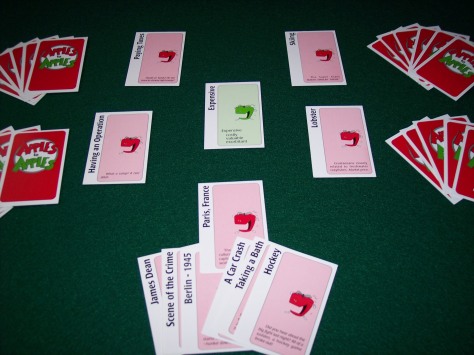
In the example above, the foreground player needs to determine which of the seven red apple cards is most likely to be chosen as ‘expensive.’ One could argue for car crash, or even for hockey, because they are both expensive in their own way, but Paris, France is expensive in many, bigger ways, so it is an excellent choice – but will the judge think so?
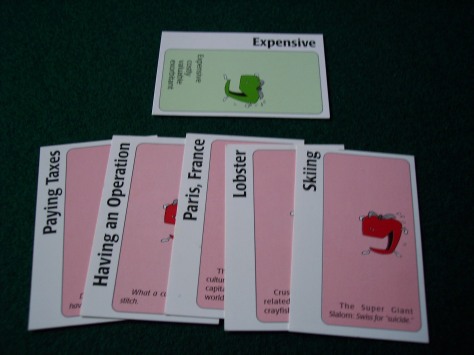
After all players have submitted their red cards, the judge has to choose one. The key is to submit a card, if you can, that will resonate with the judge. In the example above, even though they might agree that Paris, France is a very expensive city to visit, or build, or whatever, they might have had a recent emotional experience with a hospitalization so the cost of an operation is what they think of when they see the word ‘expensive.’ The judge could also be more impressed with the cost of lobster, or skiing, or even paying taxes. And so it goes. The judge chooses which red card they like the best, and the players who didn’t win usually let the judge know exactly why their cards were better choices…and the conversation continues. Arguments are defused by the cards being anonymously submitted, and by the explicit rule that the judge can use any way of determining what is the best card.
Apples to Apples is easy to learn, and everybody plays at once (which is typical of games by Out of the Box). Game play typically lasts about a half hour, but any number of rounds can be played. Rounds are so quick that you can get a few done in very little time. It is very common to simply play the game without regard to a winner; people just like to play for the fun of it.
There are a number of expansions and variations available. Expansions ($19.99) are basically the same game with all new cards, which is nice to have because they can be mixed together with the original cards. There are at least 12 stand-alone variations on the basic Apples to Apples game, including Apples to Apples Jr (Out of the Box, 2002), which will be reviewed elsewhere.
I absolutely recommend this game to just about anyone in the market for a game, especially if looking for a game to appeal to a mixed-age group. It’s great for families, groups of friends and coworkers, and is safe as a gift to just about anybody.


